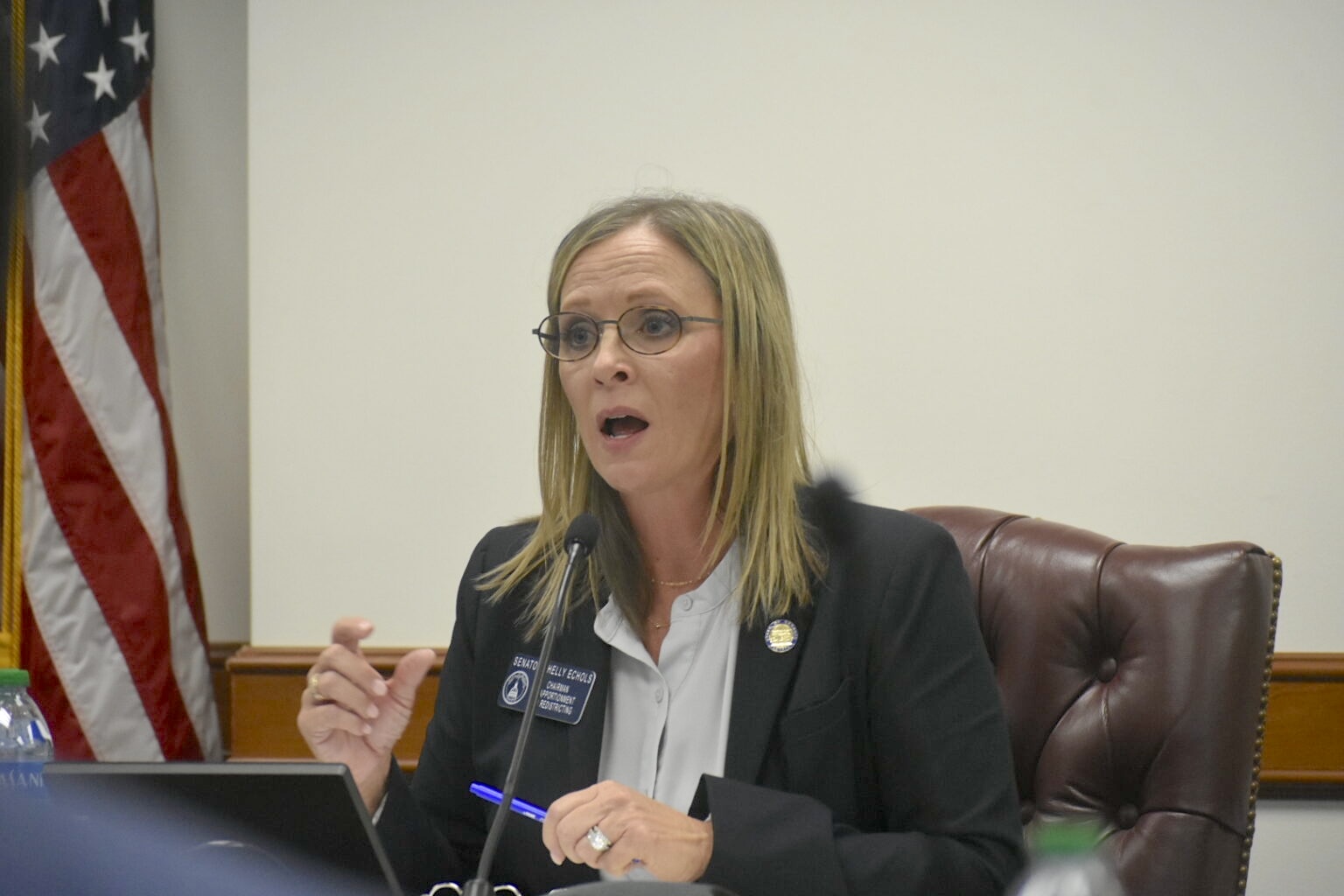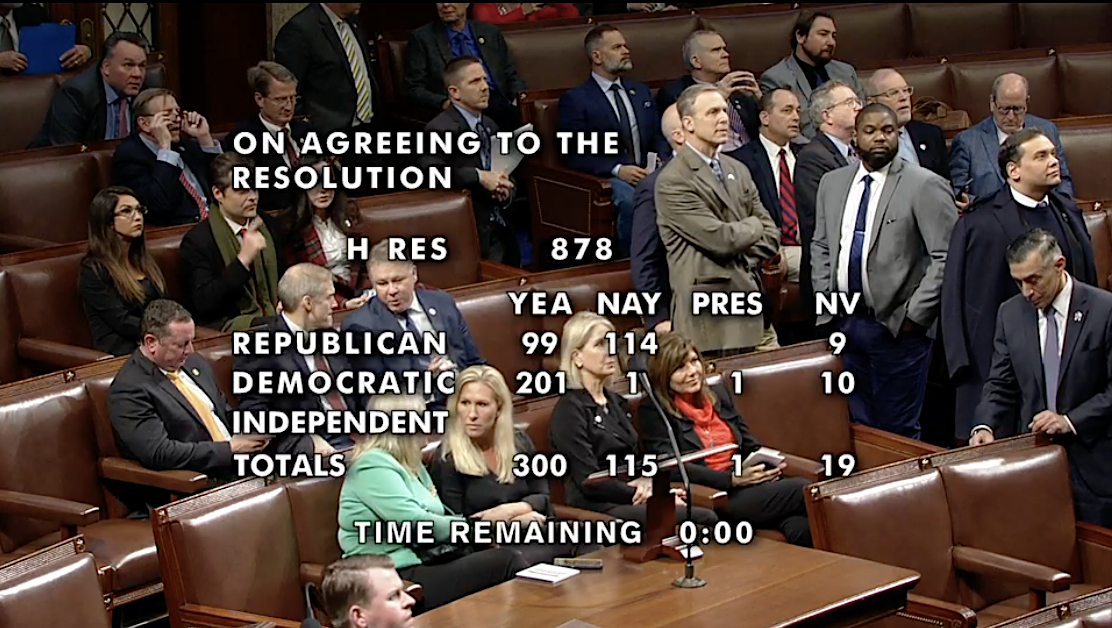WASHINGTON (States Newsroom) — New York Republican George Santos on Friday became the sixth lawmaker in history and the first member of the GOP to be expelled from the U.S. House of Representatives.
The 311-114 bipartisan vote, which required two-thirds support, followed months of scandal that culminated in a federal criminal indictment and a damning report from the House Ethics Committee. Two Democrats voted “present,” and 105 Republicans voted for expulsion.
Of Nebraska’s three Republican House members, Don Bacon and Mike Flood voted to expel Santos, while Adrian Smith, R-Neb., voted against expulsion.
Several Republicans said during debate Thursday that the lies Santos allegedly told to raise funds and get elected, as well as misuse of campaign funds, should bar him from finishing his term.
“He has manufactured his entire life to defraud the voters of his district an honest choice for a member of Congress,” said New York Republican Rep. Marc Molinaro. “He has lied to donors and to colleagues, taking advantage of election law, using campaign funds to personally benefit himself. And he has defamed not only his office, but the institution itself.”
Pennsylvania Democratic Rep. Susan Wild, the ranking member on the Ethics Committee, said during floor debate that Santos should no longer hold a seat in the House of Representatives.
“One of our most basic obligations as members of Congress is to adhere to the principle that public office is a public trust,” Wild said. “As the Ethics Committee’s report lays out in thorough detail, Mr. Santos has repeatedly, egregiously and brazenly violated the public’s trust.”
‘Santos must be held accountable’
The five-page resolution that expelled Santos was sponsored by Ethics Committee Chair Michael Guest, a Mississippi Republican.
In addition to summarizing the panel’s findings, the resolution stated that “Santos must be held accountable to the highest standards of conduct in order to safeguard the public’s faith in this institution.”
During floor debate, Guest said that Santos had lied about his education, employment by Citigroup and Goldman Sachs, his religion and having employees die at the Pulse nightclub shooting.
“While troubling, those lies did not justify his removal from this body,” Guest said. “But these and other misleading statements reflect directly on Mr. Santos’ credibility.”
The Ethics Committee report, Guest said, detailed more egregious issues, including that Santos spent campaign funds on personal rent, personal credit card payments, luxury goods, Botox and the website OnlyFans. The report also alleges Santos made fictitious loans to his campaign account that he later paid himself back for.
“In addition to these questionable expenses, there were travel expenses, questionable expenses involving trips to Atlantic City, Las Vegas, Nevada and the Hamptons,” Guest said.
Santos, Gaetz urge against expulsion
Santos, who is 35 years old, has defended himself throughout the months-long saga and held a press conference Thursday morning to rebuke efforts to remove him as a U.S. lawmaker before his criminal case goes to trial.
“They are trying to join me to the group of three Confederates and two people convicted in a court of law,” Santos said, referring to other members expelled from the House. “I will be number six in the history, the first Republican, and the only one without a conviction or without having committed treason.”
During floor debate, Santos criticized Guest for including a reference to sexual misconduct in the resolution the House voted on, even though the Ethics Committee didn’t conclude that Santos had participated in such behavior.
“Am I guilty of a sexual harassment claim, or am I not? The report says I’m not, his filing on this expulsion resolution says I am,” Santos said. “That is a very serious allegation, one that I sought to see the end of.”
The Office of Congressional Ethics, Santos said, “sent a referral to the investigative subcommittee saying that they did not suggest further investigation into the matter because it lacked credibility.”
“Yet, it sits on their expulsion resolution,” Santos said. “I call that hypocrisy, more lying, more swamp behavior from this body.”
Florida Republican Rep. Matt Gaetz said during floor debate that if Santos is convicted during an upcoming trial, the House should expel him, but urged his colleagues not to take that step before then.
“I rise not to defend George Santos, whoever he is, but to defend the very precedent that my colleagues are willing to shatter,” he said.
Gaetz expressed frustration that the House had not taken a vote to expel New York Democratic Rep. Jamaal Bowman after he pleaded guilty to pulling a fire alarm in one of the House office buildings.
Gaetz also criticized the Senate for not voting to expel New Jersey Democratic Sen. Bob Menendez, who was indicted in September on several charges, including conspiracy to commit bribery. Menendez received a superseding indictment in October that charged him with numerous other crimes, including acting as an unregistered foreign agent.
“Whatever Mr. Santos did with Botox or OnlyFans is far less concerning to me than the indictment against Senator Menendez,” Gaetz said, referring to allegations that Santos used campaign funds to purchase cosmetic procedures and a subscription to the website that is predominantly known for pornography and other types of sex work.
Special election
The expulsion means that residents in New York’s 3rd District will vote in a special election within the next few months to fill the seat that has swung between Democrats and Republicans over the years.
The district covers parts of Long Island, including a northeastern section of Queens and much of Nassau County.
Santos won election to his first term in November 2022, when he garnered about 20,000 more votes than his Democratic opponent.
The district was represented by Democratic lawmakers for the prior decade. Its residents were represented by a Republican from 1993 until 2013, though the shape of the district has changed somewhat over the years.
The election could further narrow Republicans’ majority in the House, making it even more difficult for GOP leaders to pass partisan legislation.
The balance of power in the House changed to 221-213 following the expulsion vote, with Republicans holding just three more seats than required to pass legislation.
News reports questioned Santos resume
A small, local newspaper on Long Island, The North Shore Leader, was the first news organization to raise questions about Santos’ resume and claims he was making on the campaign trail.
The paper published a story before the November 2022 election noting that Santos’ personal financial disclosure report said he was worth about $11 million when the paperwork he filed two years earlier during another run for office said he didn’t have any assets worth more than $5,000.
The story also noted that Santos had previously reported $600,000 in loans to his own campaign in reports to the Federal Election Commission, though he didn’t include that in his personal financial disclosure report.
The article never gained much attention in national publications, but questions about Santos came to the forefront after The New York Times published a story in December 2022 alleging that Santos fabricated much of his resume.
Numerous other news organizations then began looking into Santos and published dozens of stories questioning claims he made during his campaign and after winning election.
DOJ charges
The press coverage garnered the attention of federal prosecutors as well as congressional investigators.
In May, the U.S. Justice Department indicted Santos on 13 criminal charges, including wire fraud, money laundering, theft of public funds and making materially false statements to the House of Representatives.
Breon Peace, U.S. Attorney for the Eastern District of New York, said at the time the indictment charged Santos “with relying on repeated dishonesty and deception to ascend to the halls of Congress and enrich himself.”
“He used political contributions to line his pockets, unlawfully applied for unemployment benefits that should have gone to New Yorkers who had lost their jobs due to the pandemic, and lied to the House of Representatives,” Peace said.
In October, federal prosecutors filed an additional 10 charges in what’s known as a superseding indictment.
Those included conspiracy to commit offenses against the United States, wire fraud, making materially false statements to the Federal Election Commission, falsifying records submitted to obstruct the FEC, aggravated identity theft, and access device fraud.
Peace said the new charges stemmed from Santos “stealing people’s identities and making charges on his own donors’ credit cards without their authorization, lying to the FEC and, by extension, the public about the financial state of his campaign.”
“Santos falsely inflated the campaign’s reported receipts with non-existent loans and contributions that were either fabricated or stolen,” Peace said.
House Ethics report
The House Ethics Committee released its report in November following a months-long investigation into Santos.
The 56-page report said that Santos “sought to fraudulently exploit every aspect of his House candidacy for his own personal financial profit.”
“He blatantly stole from his campaign. He deceived donors into providing what they thought were contributions to his campaign but were in fact payments for his personal benefit,” the report says.
Santos “reported fictitious loans to his political committees to induce donors and party committees to make further contributions to his campaign — and then diverted more campaign money to himself as purported ‘repayments’ of those fictitious loans.”
“He used his connections to high value donors and other political campaigns to obtain additional funds for himself through fraudulent or otherwise questionable business dealings,” the report says. “And he sustained all of this through a constant series of lies to his constituents, donors, and staff about his background and experience.”
History of House expulsions
Congress is granted the ability to “punish its Members for disorderly Behaviour, and, with the Concurrence of two-thirds, expel a Member,” according to the U.S. Constitution.
The U.S. House has used its authority before Friday to expel five members, while the Senate has removed 15 lawmakers.
Three of the House members previously expelled — John B. Clark and John W. Reid, both of Missouri, and Henry C. Burnett of Kentucky — were kicked out for “disloyalty to the Union” in 1861 amid the Civil War.
In 1980, House lawmakers expelled Michael J. Myers of Pennsylvania for bribery, conspiracy and Travel Act violations.
In 2002, the House voted to remove James A. Traficant of Ohio for illegal gratuity, conspiracy, obstruction of justice, defrauding the government, racketeering and tax evasion violations.
Senators voted to expel 14 lawmakers turned Confederates between 1861 and 1862 for “disloyalty to the Union.”
The other senator expelled, William Blount of Tennessee, was removed from Congress in 1797 for “disloyalty to the United States.”
Blount, who was experiencing “serious financial difficulties,” had “concocted a scheme for Indians and frontiersmen to attack Spanish Florida and Louisiana, in order to transfer those territories to Great Britain,” according to the U.S. Senate Historical Office.
“Unfortunately for the senator, a letter, in which Blount thinly disguised his desire to arouse the Creek and Cherokee Indians to aid his plan, fell into the hands of Federalist president John Adams.”



















